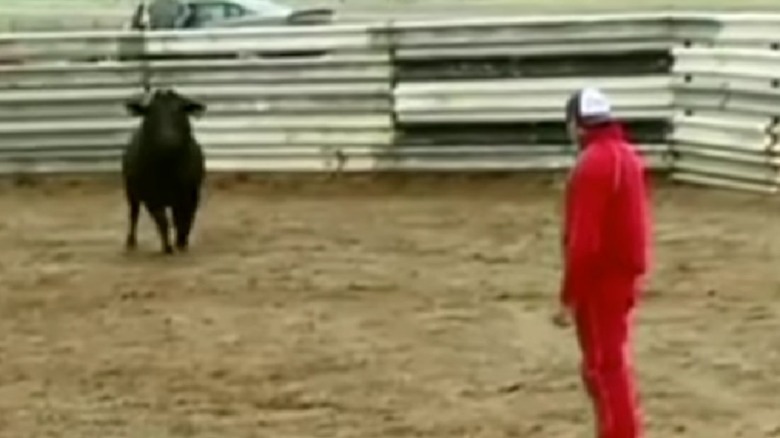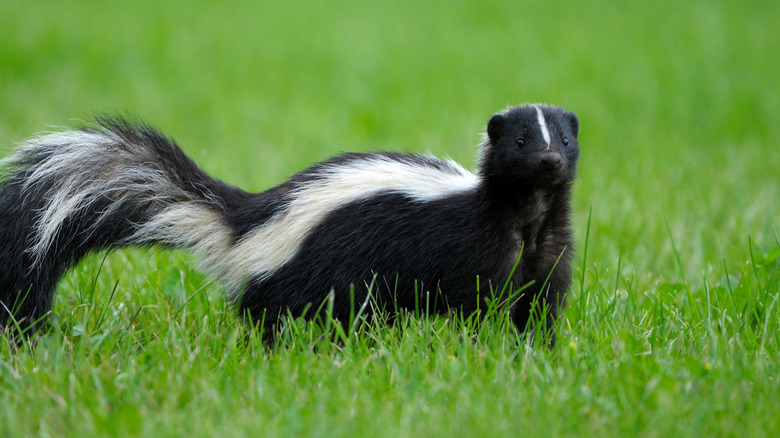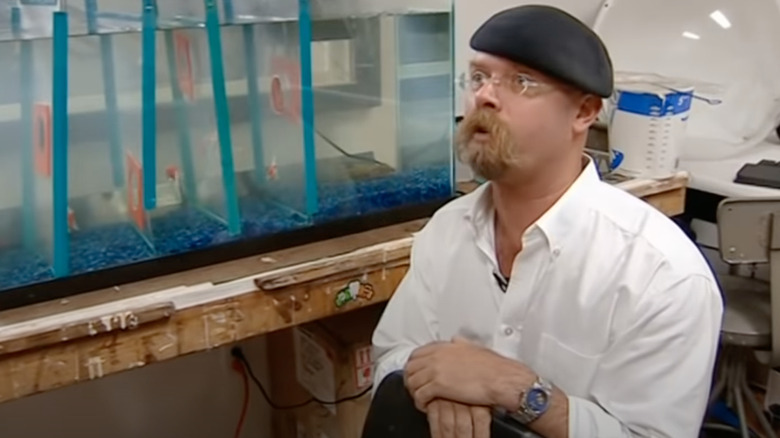The Best Animal Myths Tested On Mythbusters
The Discovery Channel's Mythbusters saw Adam Savage and Jamie Hyneman testing a myriad of myths: serious, outrageous, or simply bizarre ones. Fairly early on in the series, the former special effects experts were joined by the Build Team, comprising TV host Kari Byron, model maker Tory Belleci, and electrical engineer/roboticist Grant Imahara (whose untimely death in 2021 deeply shook the MythBusters cast). The myths they tested ranged from movies to crime to germs (and pretty much all categories you can think of). But some of their best (and arguably, weirdest) myths revolve around the animal world.
Hyneman and Savage descended into a swarm of frenzied sharks, covered themselves in skunk musk, and faced their worst fears (in Savage's case, bees) for the sake of science. Indeed, the Mythbusters have done a great job at verifying decades-old myths and reminding viewers not to believe everything they read or see in a movie. Without further ado, here are some of the best animal myths tested on Mythbusters.
Can cockroaches survive a nuclear blast?
After journalist Richard Schweid reported that cockroaches had survived the Hiroshima and Nagasaki nuclear blasts in 1945, Slate notes a myth that cockroaches would inherit the Earth was born. One 1968 article in The New York Times even highlighted a 1965 ad from the National Committee for a Sane Nuclear Policy: "The winner of World War III will be the cockroach." As always, the Mythbusters had to check if the bug really is the most resilient around.
In Mythbusters' episode from 2008, Kari Byron, Tory Belleci, and Grant Imahara tested three types of bugs against three levels of radiation, all high enough to kill a human being: 1,000, 10,000, and 100,000 rads. They exposed fruit flies, cockroaches, and flower beetles over a period of 30 days (each species being split into three radiation groups), to see how many would survive from each species. All bugs did an impressive job at being sturdy, but when it comes to cockroaches inheriting the Earth, the Build Team had a surprise.
The cockroaches did much better than humans would: 50% had survived 1,000 rads (the lethal dose for us), and 30% had survived 10,000 rads. However, the 100,000 rads exposure was too much for them — but not for the other insects. Fruit flies did a little better than cockroaches (unfortunately, dying of natural causes before the team could draw an exact conclusion), and 10% of the flower beetles had even survived the 100,000 rads. The myth? Busted.
Does the color red make a bull charge?
Remember when Bugs Bunny waved a red muleta at a bull (and surprised him with an anvil)? Bulls being triggered by the color red was taken as a fact and shown in movies for a long time, so the Mythbusters conducted a few tests to check if there is any real connection between bulls and red. Perhaps unsurprisingly, their tests got increasingly dangerous.
The Build Team initially placed red, blue, and white flags in the arena and left the bull alone with them (via Watch Mojo). He charged all three flags with equal interest. Then, Kari Byron, Tory Belleci, and Grant Imahara built a remote-controlled clothesline that waved the flags in front of the bull. This moment revealed the actual truth behind the muletas: It's movement, not color, that ignites a bull. When the team placed different colored matador dummies in the ring, the bull charged at all three of them. Of course, the Build Team also took it up a notch by sending their designated guinea pig Belleci into the ring, dressed in red. But he wasn't moving. The two cowboys dressed in non-red were. Guess what: The bull chased them. Busted.
Since the MythBusters' episode in 2007, it has been proven scientifically (via Live Science) that bulls are in fact colorblind, and that it's the movement of the capes (red or not) that triggers them to charge.
Does a duck's quack really have no echo?
Arguably one of the cutest did-you-knows you might have read in "Amazing Animal Facts" books is that a duck's quack has no echo. But after watching Mythbusters' episode 8, several editors would've wanted to publish updated editions. Firstly, the Mythbusters found out that it's pretty hard to make a single duck quack. Once paired, the duckies began chatting, and for a minute, no echoes could be heard. But the Mythbusters knew better than to leave it at that.
They had the ducks examined by an audio expert. The verdict? Because the quack and its echo sound are so similar to the human ear, the echo is practically "swallowed" by the quack. Ducks' quacks do have echoes, but our ears are too basic to perceive where the quack ends and the echo begins. The Guardian reported just that back in 2003, and Jack the Lad from Heart Breakfast also had ducks quack to each other inside a shed, proving a slight echo could be heard, especially when the ducks quack into a microphone. Another myth busted.
Does the scent of a dead shark repel sharks?
Jamie Hyneman's and Adam Savage's appreciation of sharks was made famous during their "Jawsome Shark Special" in 2012. Toward the end of Mythbusters, they went back to the topic to test a myth based on fishermen's stories (via Discovery) that if you drag a dead fish behind your boat, it prevents sharks from snatching your catch. No, Savage and Hyneman did not kill a shark, nor did they tie a dead one to their boat.
Instead, they concocted a "distilled essence of dead shark" (which of course Savage smelled). They hid a box full of yummy dead fish inside a rock and let the sharks come to it, attracted by the smell. When around 15 sharks had gathered, Hyneman descended into the swarm and released the essence. The sharks hated it, fleeing in a matter of seconds. But just to make sure, Savage came up with a slightly more dangerous plan: They would generate a feeding frenzy by throwing food at the sharks. But again, all sharks fled the scene. In both cases, it took them approximately six minutes to start coming back.
It's also worth mentioning that the Mythbusters tested this myth on Caribbean reef sharks and nurse sharks, but the essence was derived from a different species. This means that the myth is confirmed for several, if not all, species of shark.
Are elephants scared of mice?
The image of an elephant having a fit at the sight of a tiny mouse is yet another trope made famous by cartoons. Is it true though? In MythBusters episode from 2007, Adam Savage and Jamie Hyneman traveled all the way to Africa to test this myth on wild elephants. Well, on natural reserve ones, as interacting with fully wild elephants could have easily gone very wrong.
You might be wondering how they got mice in the proximity of the gentle giants. Quoting Hyneman's wise words, "Well, where there are elephants, there's elephant dung." They thus dug a hole in a ball of dung, hid the mouse inside, covered the hole with a piece of cardboard, and flipped the dung when an elephant passed by. Both Mythbusters were adamant that this would be an easy bust, but it truly wasn't. When they exposed the mouse, the elephant made a startled sound, raised its trunk, and backed off.
Not believing what they saw, Hyneman and Savage proceeded to lift an empty dung ball, thinking maybe it was the flipping that scared the elephant. Nope: The elephant walked right passed the flipping ball. The Mythbusters repeated the first test with a different elephant and, although it appeared less startled, it very clearly steered away from the mouse. The conclusion: The myth is confirmed, albeit with the sidenote that their reaction isn't as severe as the one shown in cartoons.
Can goats be startled into fainting?
If you've heard of the Tennessee fainting goat, then you probably assumed what they're best known for. After seeing several videos of these poor goats falling over for all sorts of minute reasons (like farmers walking past and startling them), Kari Byron and Tory Belleci visited a fainting goat farm and tried their best at startling the goats stiff (via YouTube).
But the job proved far more difficult than they had expected (one of the goats was not only unfazed by the two, he also headbutted Belleci in the groin). Byron tried to startle the goats by opening a large umbrella in front of them, then chasing them with it. Then, Belleci lay down in a trough, and Byron covered him with tasty hay for the goats to eat. Five minutes later, Belleci burst out of the trough. Both attempts failed — the goats simply ran off. Byron also exposed herself in front of male goats, but to no avail (well, Belleci fainted).
Finally, the two tried disguising themselves as farm animals, suddenly becoming bipedal and screaming at the goats around them. At last, some results: Several goats fainted. It's worth clarifying this, though: Tennessee fainting goats don't faint per se. They have a hereditary condition that causes them to involuntarily stiffen their legs when scared, as per ThoughtCo. — they simply fall over. Nevertheless, myth confirmed.
Is it impossible to catch a greased pig?
Greased-pig contests have been a long-standing tradition in the United States (via The Marietta Times), although it's arguably among the more outrageous ones (and a pretty stressful experience for the pigs). However, this didn't stop the Build Team from testing the theory (via Discovery) that it's impossible to catch a greasy pig (Tory Belleci assured MythBusters viewers that the Walnut Keep farmers taught them how to handle the pigs gently).
Kari Byron began by greasing the pigs with an animal birthing agent. Then, as the pigs were released into the pen one by one, the team attempted to catch the pigs and take them to the 8-foot-diameter circle in the center of the pen. Byron caught her 25-pound piglet in 55 seconds (she says she would have done so even faster had she not freaked out at touching birthing agent, mud, and poop). Grant Imahara caught a 40-pound pig in two minutes, and Belleci managed to seize a 150-pound pig in just under five minutes, as per Myth Results. Needless to say, the myth was busted.
The Build Team also earned their name by designing three devices to catch the pigs safely. Byron's furlined gloves proved to be the most efficient, with Imahara's huge pincers and Belleci's vacuum-cleaner backpack equipped with suction cups proving more of a hindrance than an aid.
Is it impossible to herd cats?
In the same 2014 episode that saw the Build Team get their hands greasy, Adam Savage and Jamie Hyneman tested another great animal myth: That it's impossible to herd cats. They started off by visiting a livestock farm and herding a flock of six sheep — both Mythbusters agreed that the sheep made this an easy job, as their instinct is to move in groups.
But when it came to herding cats, Savage and Hyneman discovered quite the opposite (via Discovery). The mission appeared simple: Direct eight cats from a large pen into a small circle pen. But before they could even touch the kitties, they started spreading and attempting to escape the large pen through the climb-proof netting. Savage and Hyneman fixed this, then Savage went on to try herding the cats. Absolutely nothing worked: It was impossible to make even two cats walk together, and when Savage tried guiding the cats one-on-one, they simply didn't care about his instructions. Not even carrying the cats into the pen worked, as some left by the time he brought the last one in.
The two had a few more failed attempts involving catnip, toys, and a sheepdog that scared the cats and caused aggressive behavior. Now, before you say, "of course, cats are solitary," they aren't. It was scientifically proven that cats are social beings, as per the New York Times, and they even have best friends. They're just not ... herdable. The myth was confirmed.
Can 1,000 bees lift a laptop?
As part of the Mythbusters' 2010 "Bug Special," Adam Savage and Jamie Hyneman tested a questionable video that showed 1,000 bees lifting a laptop. The Mythbusters proceeded to cover a laptop in bee-friendly adhesive and honey and gathered a serious bee workforce for the job. There was no chance of lifting the laptop. Savage and Hyneman found that 23,083 bees would be sufficient to lift it in theory, with only one small issue: The laptop's surface could only fit 2,340.
Furthermore, Hyneman explained a basic physics problem about bees lifting a laptop. The bee, as it's attached to a large flat surface, pushes its wings up and down in an attempt to fly. As it pushes down, it blows air into the surface it's trying to lift. The air moves sideways, instead of down past the laptop (which is something that would need to happen in order to lift it). Hyneman proved just that with six tiny helicopters attached to a wooden surface (the helicopters only lifted the surface when it had several holes in it).
With the myth busted, Savage went back to the bee farm and proved how the video could have been faked: using high-strength fishing line and a puppeting rig. He proved his special effects expertise, and he also temporarily conquered his very strong melissophobia.
Can you remove the smell of skunk musk?
Skunk smell is not a myth (if you've never been sprayed by a skunk and you're curious how it smells, it's a mixture of thiols, the same chemicals found in feces and rotting bodies). However, the Mythbusters wanted to find out whether it was possible to remove the smell using a wide range of products.
According to Annotated Mythbusters, critter control brought the Mythbusters three skunks who initially refused to spray them. Even the synthetic musk was a failure, as the stench wore off quickly. On the third day, the third skunk was freed inside a bathroom with Savage and Hyneman. Before long, they were covered in musk.
As Myth Results details, first, the pair got covered in tomato juice. The smell only temporarily masked the musk — once the human nose got used to the tomato smell, the skunk one came back. Beer and personal hygiene products were a complete failure, only creating a bizarre mix with the vile musk. Finally, the two tested a home mixture of soap, baking soda, and hydrogen peroxide. This seemed to do the trick, leaving the once-thoroughly-sprayed bathroom smelling as good as new. The Mythbusters also tried commercial skunk remover on the stench, but it wasn't half as good as the custom mixture. So, can you remove skunk musk? Well ... kind of.
Is spider silk stronger than steel?
Although Mythbusters ended in 2016 (via Distractify), Adam Savage came back to the TV screens in 2019 with a season of MythBusters Jr. (which was seriously praised by The Los Angeles Times). Savage and his junior team tested the age-old myth that spider web is stronger than steel (via the Science Channel). First, they compared 500 strands of spider silk against a fine steel wire of the same density and proved that the silk was twice as strong — so as always, Savage took it up a notch.
The team had a 28-gauge steel wire and a 25,000-strand spider silk rope (collected from 42 spiders over five weeks) compete in holding a gradually filling water bucket. The steel wire snapped when the bucket had 12.5 pounds of water inside. The spider silk held 26 pounds before it burst into tiny curly bits of strand. Once again, the spider silk proved twice as strong as steel. Myth confirmed.
But, as Science reports, spider silk is actually much sturdier: It's five times stronger than steel. Apparently, each strand (which is 1,000 times thinner than a human hair) is made of nanofibers that create perfect "silken cables."
Does a goldfish really have a goldfish memory?
In MythBusters episode from season one, Jamie Hyneman and Adam Savage conduct one of their most animal rights-centered tests. Their visiting scientist argued that the myth that goldfish have a 3-second memory is a human construct designed to make ourselves feel better about keeping them in tiny enclosures (by the time a goldfish completes a circle in a tiny round bowl, the myth says, it will have already forgotten the circuit).
Indeed, Savage and Hyneman demonstrate the goldfish are much more intelligent than that by building mazes for them to swim through. The duo in fact competed in training their five goldfish over 45 days. Hyneman, who once owned a pet shop and trained a lion, even trained his fish to recognize color patterns. His fastest fish swam through the maze in 25 seconds. Savage lost three fish due to ammonia-contaminated water, and his fastest fish finished the maze in nine minutes, much to his chagrin.
Considering the goldfish learned the task, then repeated it over several days, it's safe to say the myth is busted.



